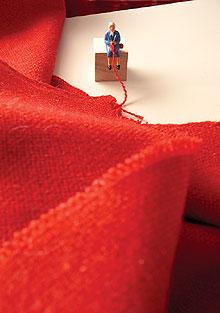Liliana Porter
dal 29/3/2005 al 7/5/2005
Segnalato da
29/3/2005
Liliana Porter
Ruth Benzacar, Buenos Aires
They and Some Others

Ruth Benzacar Gallery opend the 2005 season with an exhibition
of works by artist Liliana Porter never shown before. This is her first solo
show in Buenos Aires after a successful retrospective held at the Centro
Cultural Recoleta during 2003.
Liliana Porter's work has strongly approached the literal
space, impelled, maybe, by the characteristic bareness and austerity of an
aesthetic shaped over many years. Her works forced approach the literal, the
obsessively literal, cautiously leaving behind the literary. In other words,
Porter does not call things by their names: she creates a space in which things
are their own name. Everything is either object or word, and based on this
premise, she articulates a rhetoric and a poetic where language is no more than
a constant impossibility and a closeness to something mysterious and
impenetrable.
In works from the late 70s Porter explored the idea of writing
with objects and/ or drawings of objects, graciously separated by punctuation
signs as if the image were a list, pure text presented to be visually devoured.
In these recent works, beyond the travesty of a syntax, Porter insists on
presenting animated objects, condensing the focus in the specifics of the thing
she literalizes, demanding "from here", from this side of fiction, to continue
the game of representation. In this way, each one does what they need to do, or,
what they did before being forever fixed on an image: designers design and
sweepers sweep, accusers accuse, and a melancholic gazes dismally at a spot on
the wall.
Each thing is also a way of naming that thing. By being
presented and re-presented in a scene, the figures acquire the density of a
metaphor and, in this way, also become figures of the language. These things
represent thought strategies, artilleries of the imagination that bring them to
a rhetoric - and its metonymic games that exchange parts for the whole in all
parts- than to the prolonged breath of a syntax.
In this way Porter raises a rhetorical thought from the
literal, a writing style many times understood as literary. And, although,
without a doubt, authors such as Borges and Carroll have informed their artistic
practices, Porter's works resist being a mere illustration of literary
strategies used to prop up fiction. Porter does, however, play with writings,
with objects summoned in a space to the point of turning them into ideograms,
with sign-scrawls traced on the wall by an idle person.
It is a writing that is a travesty and is merciless with its
own scribe, who seems to be its clearer sign. It is not reversible, but it is
logical: cause and consequence, before and after are open elements now in the
scene. And by opening up, they disarrange, they align or change places,
discarding the tyrannical relationship that preceded them. Nonetheless, they
resist chaos. Instead, they celebrate the mystery.
José Luis Blondet February 2005
LILIANA PORTER
Born in Buenos Aires in 1941. In 1954 she began her studies at
the Escuela Nacional de Bellas Artes Manuel Belgrano. (National School of Fine
Arts Manuel Belgrano)
From 1958 to 1961 she lived with her family in Mexico City,
Mexico. At the Universidad Iberoamericana of that city she studied with German
artist Mathias Georitz and specialized in engraving techniques with Colombian
artist Guillermo Silva SantamarÃa. Upon her return to Buenos Aires, she
continued her training with Fernando López Anaya and Ana MarÃa Moncalvo.
In 1964 she moved to New York. She worked at the Pratt Graphic
Art Center and created the New York Graphic Workshop together with two artists:
the Uruguayan Luis Camnitzer and the Venezuelan José Guillermo Castillo. In 1977 she co-founded the Studio Camnitzer-Porter, in Lucca,
Italy, where she was also an engraving instructor.
In 1980 she received a Guggenheim Fellowship. Since then, she
has been granted seven research Fellowships in photography, video and multimedia
at the City University of New York (PSC-CUNY). In 1991, the Bronx Museum in New
York, presented a retrospective exhibition of her work and achievements. Since
that same year, she has been a professor at Queens College, City University of
New York.
Image: Trabajo Forzado, Tejedora, 2005. Mixed Media
Ruth Benzacar Gallery
Florida 1000 Buenos Aires, Argentina
Hours: Monday through Friday 11:30 am. - 8:00 pm Saturday 10:30 am to 1:30 pm



